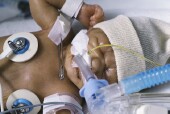 |
 |
 |

Strokes Can Strike the Youngest
Brain attacks can even happen in the womb, and new guidelines address issue|
|
HealthDay
Thursday, August 21, 2008
 THURSDAY, Aug. 21 (HealthDay News) -- Dawn Marie Perkins wasn't even seven months pregnant with her twin boys when she knew something had gone terribly wrong.
THURSDAY, Aug. 21 (HealthDay News) -- Dawn Marie Perkins wasn't even seven months pregnant with her twin boys when she knew something had gone terribly wrong.
After numerous tests and evaluations, Perkins quickly learned that strokes aren't something that just happens in the elderly; they can even strike an infant still in the womb.
Her son, Elijah Perkins, experienced a hemorrhagic stroke before he was born. It's not as rare as many might think. An estimated one out of every 4,000 babies born in the United States will have a stroke before they're 28 days old, according to new guidelines issued by the American Heart Association on managing childhood stroke.
"Most people do not think that young people have strokes," said Dr. Jose Biller, one of the authors of the new guidelines and chairman of the department of neurology at Loyola University Health System in Chicago. "But the point people should really understand is that they can occur in utero, they can occur in the neonatal period, and they can occur in older children. There are noticeable differences in presentation, risk factors, and the prognosis in children compared to older adults, however," Biller added.
Perkins said people are almost always surprised when she tells them about what happened to her son. "People are like, 'Kids don't have strokes.' So, I still think there's a lot of work to be done in terms of awareness," she said.
One of the biggest differences between childhood strokes and those that happen in older people is that far fewer of strokes in children are what's known as ischemic strokes. In an ischemic stroke, the blood supply to the brain is cut off, sometimes by a blood clot or possibly due to sickle cell disease. Without blood, the brain can't get the oxygen it needs to survive. Ischemic strokes are the most common in adults, according to Biller, accounting for 80 percent to 85 percent of strokes. In people under 18, about 55 percent of strokes are ischemic.
About 45 percent of strokes in children are hemorrhagic. Hemorrhagic strokes occur when a blood vessel in or on the brain bursts, causing blood to pool in the brain and depriving it of oxygen.
Some of the risk factors for stroke in childhood include sickle cell disease, heart disease, trauma and certain infections, according to the AHA guidelines, which were expected to be published in the September issue of Stroke.
Symptoms include:
- Sudden weakness or numbness occurring on the face, arms or legs, especially if it's one-sided.
- Sudden difficulty speaking or understanding what's being said.
- Confusion.
- Sudden trouble walking or a loss of balance.
- Dizziness.
- Sudden vision loss or difficulty seeing.
- Severe, sudden-onset headache.
As with adults, the prognosis for children varies. Generally, the faster you can get your child to the hospital, the better the prognosis, though not all of the treatments available to adults are available for the treatment of children. Perkins' son is almost 6 and has had to undergo years of physical and occupational and vision therapy, and he still has weakness on his right side, but Perkins said her son has made incredible progress, even more than doctors expected he would.
"The prognosis at the beginning wasn't very good. Eighty-five to 90 percent of the brain tissue on his left side is gone. The doctors thought he'd be in a wheelchair, that he'd never be able to walk or talk. He struggles a bit, and it may take him a little longer, but he does it all now," Perkins added.
HealthDay
Copyright (c) 2008 ScoutNews, LLC. All rights reserved.
Related News:
More News on this Date
Related MedlinePlus Pages:
| Home | Health Topics | Drugs & Supplements | Encyclopedia | Dictionary | News | Directories | Other Resources | |
| Disclaimers | Copyright | Privacy | Accessibility | Quality Guidelines U.S. National Library of Medicine, 8600 Rockville Pike, Bethesda, MD 20894 National Institutes of Health | Department of Health & Human Services |
Date last updated: 22 August 2008 |




